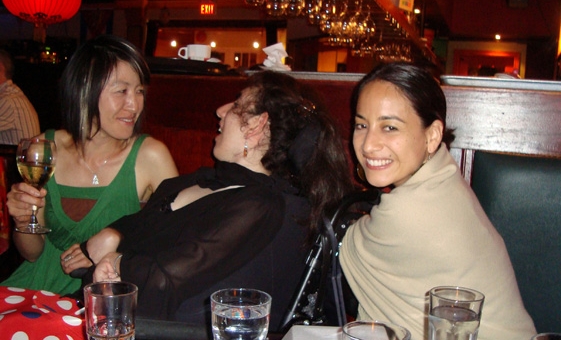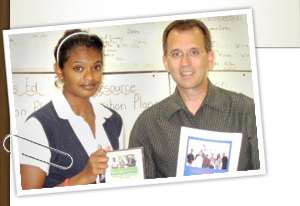Teach about Disability
Talk about disability in ways that normalize it. Topics like disability can be difficult to discuss. They tend to make people feel awkward and uncomfortable. Don’t let this stop you. If you have a student with a disability in your school, open conversation will end the wondering and whispering or studied ignoring on the part of the other students. Remind them that everyone will become disabled in some way at some point in their lives. Speak about the potential of people with developmental disabilities to care about others and to develop faithful reciprocal relationships. Tell stories that reveal their positive impact on others.

Teachers Invite Rebecca to Visit their Class
In this photo Rebecca Beayni is out at a dance nightclub with friends. Rebecca does not talk but she was in regular classrooms when she was in school. The other children attended her birthday parties and she went on outings with her classmates. Some of them became paid helpers after school and some of these helpers became permanent friends. As an adult today Rebecca visits schools to help them learn about disability. She shows her video to help others get to know her. She also is part of a dance troupe that includes people in wheelchairs. The troupe performs for schools and other groups. Her message is that a person with a disability can lead an interesting life.
Language affects how we and others think and act. We benefit today from language that puts people first, but insensitive two-tiered language persists. Model language that builds esteem, encourages mutual respect, and brings people together. The object is not to deny differences - to do so feeds into the myth that difference is not good - but to look for ways to express difference that are honest but convey equality and a valuing of diversity.
Often lack of understanding is a reason for the large gap between ‘typical students’ and those with disabilities. By helping your other students understand “what the deal is” with students with disabilities, you can help with the initial step towards understanding. And understanding can lead to friendship.
Mainstream students need to go through “compassion exercises” so as to understand what it is like to have a disability. This would break down walls and create an atmosphere of caring.
SLE, BC
Be sensitive and prepare before speaking about a specific student.
Take time to get to know the student and identify the student’s gifts for yourself - this will help you and others. Before you speak about this subject to the entire class, sit down with your student who has a disability and possibly a family member and discuss this option. Ask for their consent. If they provide it, ask them how they think you should approach this topic. Find out if your student wants to participate in this discussion.
The ideal may be for this student to speak first, explaining that they cannot do certain things but that they would like to be friends with the others and are there in class because they want to learn in the ways that they are able to learn. If they have difficulty with speech they can still talk and you or their educational assistant can repeat what they say in a normal, conversational manner: “You said that…. That’s okay or good. I am glad that you are in my class.”
A Best Practice:
The following statement is included in the front material for the Saskatchewan Grades 1-9 Social Studies curriculum:
Portrayal of Persons with Disabilities
Persons with disabilities have often been depicted inaccurately in print, media, and other classroom resources. Stereotypical depictions have served to give readers, listeners, and viewers inappropriate information and have engendered attitudes ranging from feelings of pity or revulsion to expectations of superhuman powers of intellect. It is critical that social studies teachers use materials that portray persons with disabilities realistically and fairly.
Wherever possible, ability rather than disability should be emphasized. Instructional materials should convey respect for the individuality of all persons, including those with disabilities. When evaluating material for use in the social studies classroom, the teacher should consider the following:
Accurate and up-to-date information should be used in the resource to describe the disability; The best approach is one where aspects of the disability are revealed, not as the main focus of the text, but through the unfolding of the documentary or story.
Stereotypes frequently found in media portrayals of people with disabilities include: pitiable and pathetic, objects of violence, or burdens who are incapable of fully participating in everyday life. Materials that include characters or people with disabilities should provide an insight into the feelings and thoughts of the individuals with disabilities. The characters of people should not be used to provoke certain feelings and thoughts in the reader, listener, or viewer (e.g. pity).
“Big Enough Dreams” is the result of a project by the Edmonton Learning Community aimed at promoting positive images of people with developmental disabilities. This document tells you where to find more information.


